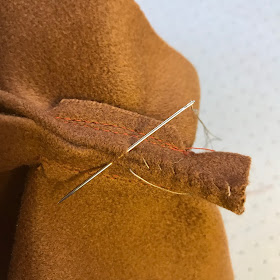BUTTONHOLES! Ready-to-wear coats and jackets usually have stitched, not bound, button holes. While I love the neat finish you get with a fine button hole twist, when making my own coats and jackets more often than not I prefer to make bound ones.
 |
| My beautiful button comes from Textile Garden, my favourite on-line button shop |
Now, there are a few ways of making a bound button hole and the method I always use now, and am going to describe here is not the way I first learned (in O'level Needlework 1969!!!) I believe the way I make them now is almost perfect. The photograph here is about 2x actual size, but I don't think anyone would actually notice the very slight incline and fractional difference in width that you may detect here in real life.
Here is how I do it. Working on the right side, keeping the facing out of the way, but including any interfacing you use, lay your front pattern piece (or button hole placement tool*) over your garment, lining it up with the front facing seam. Using an erasable marker (I use tailors chalk but always test on spare fabric first) make dots where the centres of the buttons will be. One at a time centre the buttons over the dots and draw a set of vertical parallel lines either side of the button and one horizontal line through the middle of the button.
Next cut a bias strip of fabric (garment fabric or contrast) 8x the width of your finished button hole edges (6cm will give you a .75 of a cm edge) Fold the long edges to the middle and press firmly (I use a lot of steam)
Cut the strip into sections 2x the diameter of the button.
Thus for a 4 cm button each little folded bias section will measure 8cm x 3cm.
Place the bias piece over your chalk marks, as shown, centering the folded edge over the parallel lines and the part where the raw edges meet along the horizontal line. Remember you are still working on the right side
Beginning part way along one of the long sides, stitch a rectangle. The long edges should be exactly midway between the folds and the cut edges in the middle and reach the parallel chalk lines at each end.
Stitch again just inside the first rectangle.
It will look like this (contrasting thread used to make it easy to see!)
Cut open the button hole using the centre cut edges of the facing, stopping just before the end and cutting into the corners. You will make a >--------< shape
Push the bias facing through to the wrong side and pull firmly wiggling it until you get the folded edges to meet and the free ends to lie flat (in a sort of tiny box pleat). Tack the folded edges together and the ends down flat
Press flat with steam if necessary from the back and then the front (be careful with steam on the front that you don't flatten the fabric too much). Make sure you tack the flapping ends of the facing down firmly, this helps keep the facing in a nice straight alignment.
Now bring the front facing back into place and tack a wide rectangle around the button hole.
Hang up your garment and check that you have the alignment correct and there are no pulls or folds, you are about to cut holes in your facing!
Next cut a slit to match the outer button hole. Using a firm grip with your finger and thumb roll the raw edge of the slit in the fabric under and hem stitch in place. You won't actually be able to roll the ends of the slit, place your stitches here very close together to make sure it is not going to pull out. If your fabric is likely to fray you can machine stitch a small rectangle of some fabric like organza over the slit and turn it to the inside before hemming the facing down.
Finally remove all visible tacking stitches
xx
c












Thanks for taking the time to post this. I made a bound buttonhole once a million years ago. I may not try it again sometime. The vintage jig is great. I have a newer one that turned up somewhere, but it doesn’t seem as button hole perfect as yours.
ReplyDelete